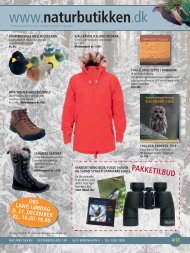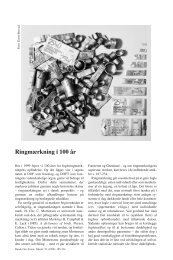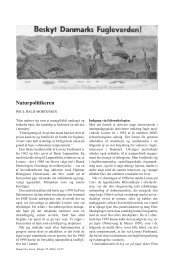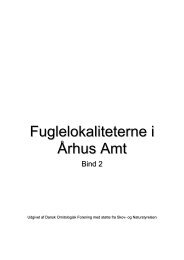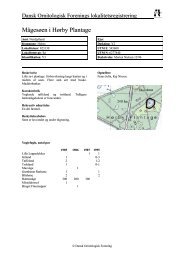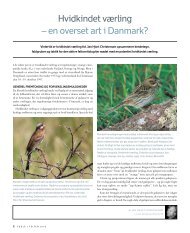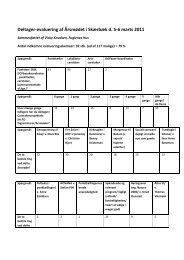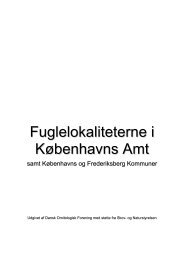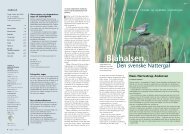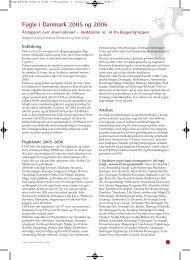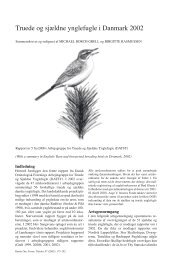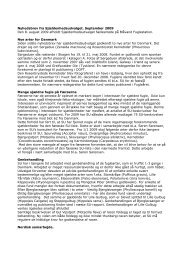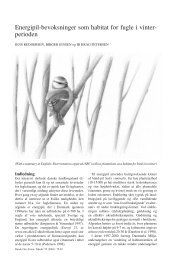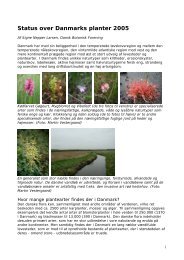Forvaltningsplanen for rød glente - Dansk Ornitologisk Forening
Forvaltningsplanen for rød glente - Dansk Ornitologisk Forening
Forvaltningsplanen for rød glente - Dansk Ornitologisk Forening
You also want an ePaper? Increase the reach of your titles
YUMPU automatically turns print PDFs into web optimized ePapers that Google loves.
11. english summary<br />
action plan <strong>for</strong> the red kite MILVUS MILVUS in denmark<br />
The <strong>for</strong>merly extensive Danish population of<br />
Red Kites was much reduced after 1870 due to<br />
persecution and the species disappeared completely<br />
around 1910. In 1922 legal protection of<br />
the Red Kite was introduced. Recolonisation<br />
took place in the beginning of the 1970’s – a<br />
few years after all birds of prey were fully protected.Very<br />
slowly, the population rose to 25-30<br />
breeding pairs in the beginning of the 1990’s<br />
(figure 2). However a few years’ later, monitoring<br />
data suggested a decline.<br />
There<strong>for</strong>e <strong>Dansk</strong> <strong>Ornitologisk</strong> <strong>Forening</strong>,Bird-<br />
Life-Denmark (DOF), decided to conduct a field<br />
study in Denmark aiming at locating all the nests,<br />
in order to gather data about breeding success,<br />
threats and habitat needs. This fieldwork took<br />
place in 2001-02.<br />
The obtained breeding results were as follows:<br />
(2001/2002): 17/18 recorded nests, 10/11<br />
successful pairs, 20/18 fledged young’s and 7/7<br />
failed pairs without breeding success. 4/5 possible<br />
breeding pairs without nests were also recorded<br />
(table 3).All together 29 different nesting<br />
sites were recorded in the 2-year study period<br />
(table 4).<br />
Compared to other neighbouring Kite populations,<br />
the Danish production of young’s per<br />
breeding pair (average 1.1) is lower and the percentage<br />
of failed breeding attempts (average<br />
40%) higher (table 8). 5 adult Red Kites were<br />
recorded dead in the breeding areas during the<br />
monitoring period. The cause of death is not<br />
known. Between 1976 and 2002 a total of 45<br />
dead kites has been reported in Denmark. Of<br />
24 examined birds, 17 died due to parathion<br />
poisoning, 6 were shot, while 1 died of collision<br />
with power lines (table 6). In recent years the<br />
number of kites with unknown causes of death<br />
44<br />
has seen an increase. Based on the results of this<br />
study DOF proposes an action plan to raise the<br />
protection level of the Red Kite in Denmark.<br />
Among the actions are the initiatives mentioned<br />
below.<br />
Despite the fact that the Red Kite is an Annex-1<br />
species in the Birds Directive, the Danish<br />
government has not designated special protected<br />
areas <strong>for</strong> this species as required by the<br />
directive. In the action plan, DOF requests the<br />
Danish Ministry of the Environment to designate<br />
5 significant core areas identified by DOF<br />
in the field study as special protected areas <strong>for</strong><br />
the Red Kite. DOF also appeals to the Danish<br />
government that the issue concerning the illegal<br />
persecution of Red Kites in Spain, Portugal<br />
& France is to be raised at top-EU level.Among<br />
the other proposed actions are: an effective ban<br />
on the possession of parathion, the establisment<br />
of an effective veterinary procedure <strong>for</strong> analysing<br />
dead kites – the latter includes analysing the<br />
dead birds <strong>for</strong> residues of rodenticides. Finally<br />
to introduce legal restrictions on the use of rodenticides<br />
in the nature. Furthermore DOF<br />
proposes to start winter-feeding of the Red<br />
Kites in an attempt to attract more adult birds<br />
to stay in Denmark.The idea is inspired by the<br />
fact that the resident populations of Red Kites<br />
in southern Sweden and in the United Kingdom<br />
both rank among the most thriving European<br />
populations and subsequently belongs to<br />
the few that are still increasing. By having more<br />
native adult birds staying in Denmark, we hope<br />
to diminish adult mortality.<br />
In order to follow the effects of the actions<br />
and the population development as such,monitoring<br />
of the Danish Red Kite population<br />
should be continued.



